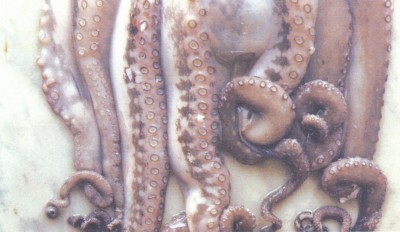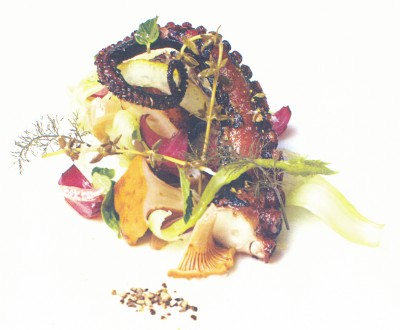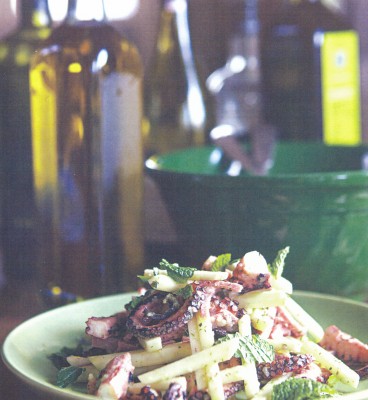FEATURE BY Willard Manus
RECIPES by Mavis Manus
It swam crossways in the direction of the "Nautilus" with great speed, watching us with its enormous staring green eyes. Its eight arms, or rather feet, fixed to its head, were twice as long as its body, and were twisted like the furies' hair...The monster's mouth, a horned beak like a parrot's, opened and shut vertically. Its tongue, a horned substance, furnished with several rows of pointed teeth, came out quivering from this veritable pair of shears..."
(Jules Verne, "Twenty Thousand Leagues Under the Sea")
Pity the
poor octopus. By nature it is a quiet, timorous creature, afraid to show
itself during the day, skulking in caves and cracks, a Casper Milquetoast
of the deep. How ironical that this most peaceful and intelligent of beings
should have been transmogrified by poulp writers like Jules Verne into
a lurid, savage thing, a bathybiotic bogeyman.

The conspiracy against the octopus has also been carried over into the
kitchen. Squeamishness aside, what spoils octopus for most people is the
traditional way it is served. Restaurants usually ruin it by chopping
it into chunks and tossing it on the charcoal: the result is something
that's about as tasty and chewy as a school eraser.
It's time to demythologize the octopus, time to rewrite not only the legends but the cookbooks. For too long now, foodlovers have been deprived of one of the sea's most succulent delicacies. Properly prepared and cooked, octopus rates on a par with lobster and shrimp. When you bite into the full-bodied white meat, the sea-taste should spread slowly and deliciously across your tongue, releasing warm and spicy bursts of flavor.
My love affair with the octopus commenced in 1964, when I quit New York and went to live in Lindos, a village on the Greek island of Rhodes, where octopus was a staple of the local diet. Curious about how octopus were caught, I made friends with a fishermen named Giorgas and watched how he went about the job.
Giorgas
fished for octopus at night, when the creatures came out to feed on their
diet of shrimp, crabs and shellfish. The technique is called pirofani--literally,
fishing with fire. A pump-up kerosene lantern was the key piece of equipment:
it was used to pick out, and sometimes attact, an octopus. Giorgas would
glide along slowly in his skiff, poised at the prow with a long-handled
trident, ready to make a quick, deft stab in the shallows.

If he spotted an octopus in deeper water, Giorgas would lower a wooden
lure lined with sharp hooks. When the octopus reached out and grabbed
the lure, Giorgas would immediately yank it to the surface. He told me
that he'd once caught a 5-ound octopus by tying an old white sneaker to
a fishing line!
If the octopus wouldn't take the bait, Giorgas would break out some stipsi, small pellets of copper sulfate, and wrap them in sailcloth which he would then shove into the hole with his trident. Finding the smell of the stipsi particularly irritating, the octopus would exit his lair in an attempt to escape. One stab of Giorgas's harpoon and the octopus's next stop was the kitchen table.
Later, when I began to spearfish in the waters around Lindos, I learned how to take octopus during the day. The trick was to look for certain signs that signalled the presence of an octopus--such as a small pile of freshly cracked-open shells. I'd start diving and looking around under the rocks, all the while holding my breath.
Octopus have excellent eyesight and will almost always see you before you see them. When that happens, the octopus will immediately camouflage himself, changing from light brown to dark grey in a second or two. When attacked, an octopus will again change color, turning bright-red when attacked. He will also use the suction cups on his arms to cling tenaciously to the sides of a boulder. And as a last line of defense, he will squirt black ink in your face in a desperate attempt to blind you.
The worst thing about octopus-hunting is the aftermath. The Lindians insisted that an octopus, once killed, must be bashed against the rocks at least fifty times to break down its muscle fibre and help tenderize it.
Once, when
I caught a big one and brought it ashore, an English tourist approached
and watched as I began to flail away at it. When I paused ten minutes
later to catch my breath, he quickly said, "My friend, wouldn't you
do better by sticking that thing under the saddle of a donkey?"

In the city of Rhodes, the fishmongers in the central market have their
own unique way of softening up an octopus: they put it through the wringer
of an old-fashioned washing machine!
Most store-bought octopus in the USA have been frozen. To insure tenderness once it's been defrosted, give the octopus a few good whacks with a mallet, then blanch it in boiling water for a minute or two. Peel off not only the outer but inner skin as well.
About two pounds of octopus will feed six. Here are some of my wife Mavis' favorite recipes:
Octopus mezze. Cut the octopus into 1-inch pieces and put in a pan of cold water barely to cover. Add half a cup of vinegar, bring to a boil and simmer until water has evaporated and the octopus turns pink (about 35 minutes). Check after 20 minutes to see if any salt is required. If not tender by the time the water has evaporated, add half a cup of water and cook further. Serve at room temperature with cocktails or as part of a platter of appetizers. Ouzo goes well with it.
Octopus stefatho. Cut 2 pounds of octopus into 1-inch pieces, saute in 1/3 cup olive oil with a finely chopped onion for 5 minutes. Add 1 lb of peeled small white onions, a bayleaf, a finely chopped garlic clove, 1/2 cup red wine, 2 tsp. tomato paste, salt and pepper to taste. Cover and simmer until tender, about half an hour. Add more water if necessary during cooking.
Suggested menu: green beans and garbanzo vinaigrette salad on a bed of lettuce. Stefatho, puree of potatoes, roughly chopped chard steamed with a little butter. Lemon sherbert and sesame cookies.
Octopus salad. Put 2 lbs of octopus in water to cover, with 2 bayleaves and a sliced onion, simmer until tender (about 35 minutes). Chop into 1-inch pieces. Put together with 1/2 lb cooked small elbow macaroni in a salad bowl. Add 2 large green peppers, an onion, 1 teaspoon of capers, 2 tablespoons gherkins, 1/2 teaspoon dill--all finely chopped. Flavor some mayonnaise with 1/4 teaspoon of curry powder and paprika, and add enough to the salad to bind.
Octopus pilaf. Cook 2 lbs of octopus with 2 tablespoons of vinegar and 1 bayleaf, covered, over low heat until tender (about 35 minutes). Cool slightly and cut in 1-inch pieces. Heat 1/4 cup olive oil and cook a finely chopped large onion and 3 peeled chopped tomatoes until softened. Add 1 teaspoon salt and pepper. Add 1/4 cup vinegar. Let it sizzle. Add 5 cups of water--include the liquid exuded by the octopus. Bring to the boil. Add 2 cups of rice. After about 10 minutes, throw in the octopus and shake the pot. Continue cooking until rice is tender and water is absorbed.
A white bordeaux or a chilled, lightly resinated Greek wine goes well with these delicious octopus dishes.
